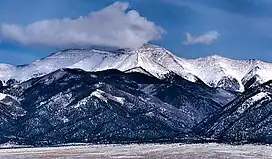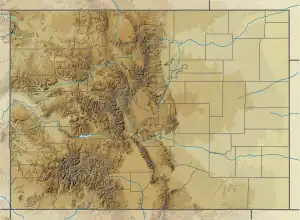| Electric Peak | |
|---|---|
 Southwest aspect in winter | |
| Highest point | |
| Elevation | 13,598 ft (4,145 m)[1][2] |
| Prominence | 961 ft (293 m)[3] |
| Parent peak | Rito Alto Peak (13,803 ft)[3] |
| Isolation | 6.04 mi (9.72 km)[3] |
| Coordinates | 38°10′54″N 105°42′30″W / 38.1817942°N 105.7082234°W[4] |
| Geography | |
 Electric Peak Location in Colorado  Electric Peak Electric Peak (the United States) | |
| Country | United States |
| State | Colorado |
| County | Custer / Saguache |
| Protected area | Sangre de Cristo Wilderness |
| Parent range | Rocky Mountains Sangre de Cristo Range[2] |
| Topo map | USGS Electric Peak |
| Geology | |
| Mountain type | Fault block |
| Climbing | |
| Easiest route | class 2[3] |
Electric Peak is a 13,598-foot (4,145 m) mountain summit on the boundary shared by Custer and Saguache counties, in Colorado, United States.
Description
Electric Peak is set on the crest of the Sangre de Cristo Range which is a subrange of the Rocky Mountains. It is the sixth-highest summit in Custer County and the 185th-highest in Colorado.[3] The mountain is located 13.5 miles (21.7 km) west-northwest of the town of Westcliffe in the Sangre de Cristo Wilderness, on land managed by San Isabel National Forest and Rio Grande National Forest.[2] Precipitation runoff from the mountain's eastern slopes drains into Brush Creek → Texas Creek → Arkansas River, whereas the west slope drains into Cotton Creek which flows to the San Luis Valley. Topographic relief is significant as the summit rises 1,200 feet (366 m) above Banjo Lake in 0.4 mile (0.64 km) and 3,200 feet (975 m) above Cotton Creek in 1.5 mile (2.4 km). An ascent of the summit involves 15 miles of hiking with 5,300 feet of elevation gain.[5] The mountain's toponym was applied by the Hayden Survey and officially adopted in 1906 by the United States Board on Geographic Names.[4]
Climate
According to the Köppen climate classification system, Electric Peak is located in an alpine subarctic climate zone with cold, snowy winters, and cool to warm summers.[6] Due to its altitude, it receives precipitation all year, as snow in winter and as thunderstorms in summer, with a dry period in late spring. Climbers can expect afternoon rain, hail, and lightning (hence this peak's name) from the seasonal monsoon in late July and August.
See also
References
- ↑ Robert M. Ormes (2000), Guide to the Colorado Mountains, Colorado Mountain Club Press, ISBN 9780967146607, p. 103.
- 1 2 3 "Electric Peak, Colorado". Peakbagger.com. Retrieved May 29, 2023.
- 1 2 3 4 5 "Electric Peak – 13,618' CO". listsofjohn.com. Retrieved May 29, 2023.
- 1 2 "Electric Peak". Geographic Names Information System. United States Geological Survey, United States Department of the Interior. Retrieved May 29, 2023.
- ↑ Mike Garratt, Bob Martin (1984), Colorado's High Thirteeners, Johnson Books, ISBN 9780917895395, p. 78.
- ↑ Peel, M. C.; Finlayson, B. L.; McMahon, T. A. (2007). "Updated world map of the Köppen−Geiger climate classification". Hydrol. Earth Syst. Sci. 11. ISSN 1027-5606.
External links
- Electric Peak: weather forecast